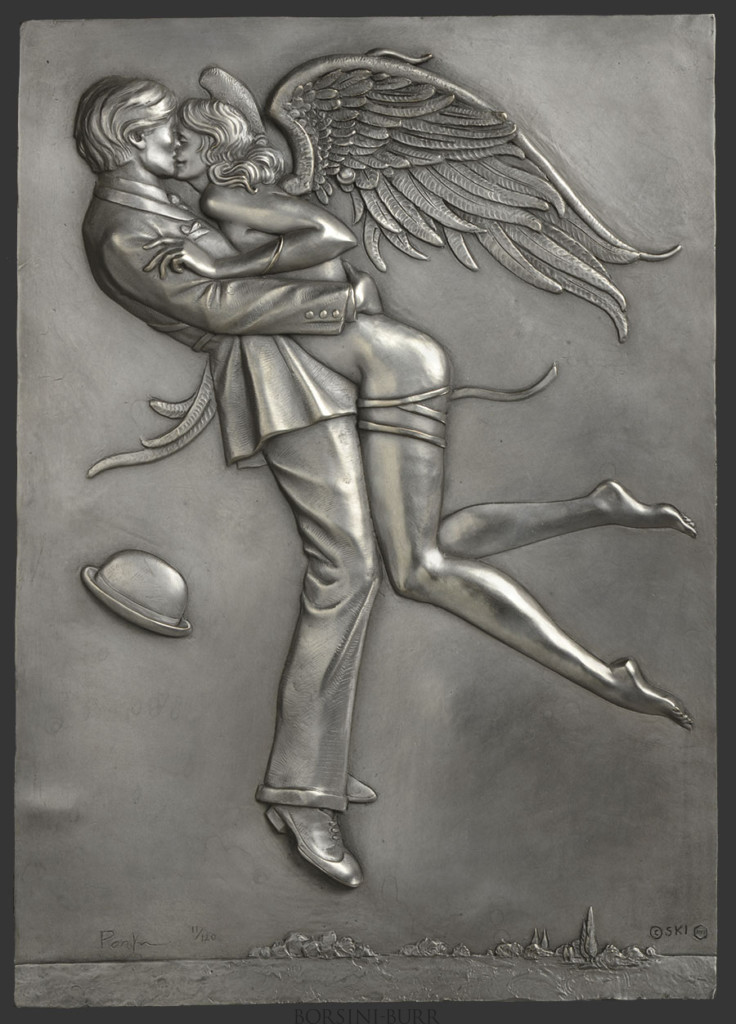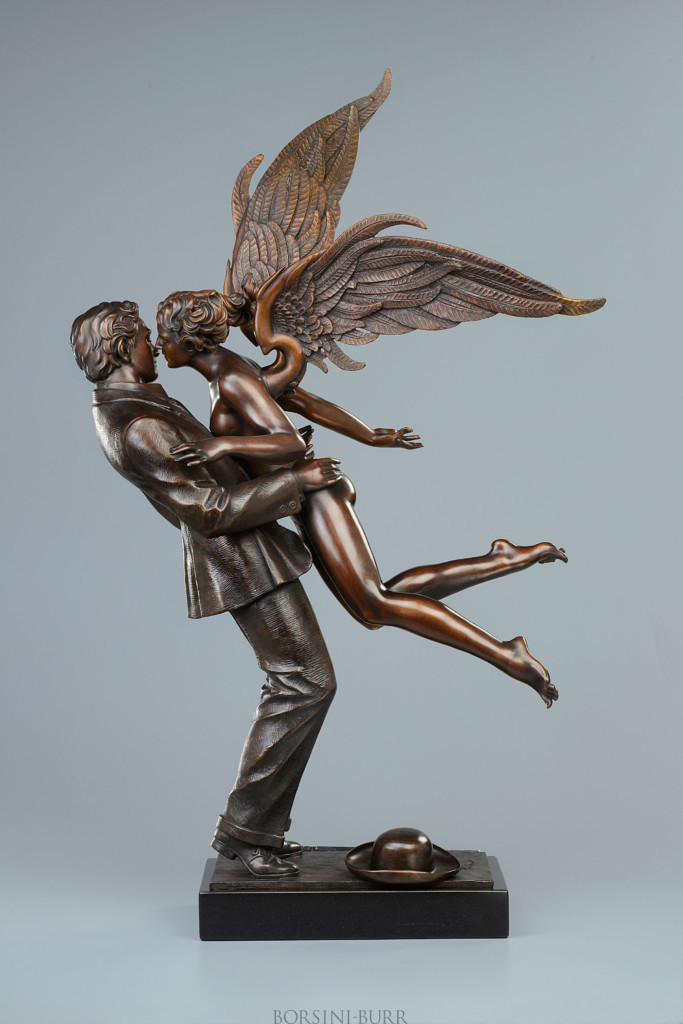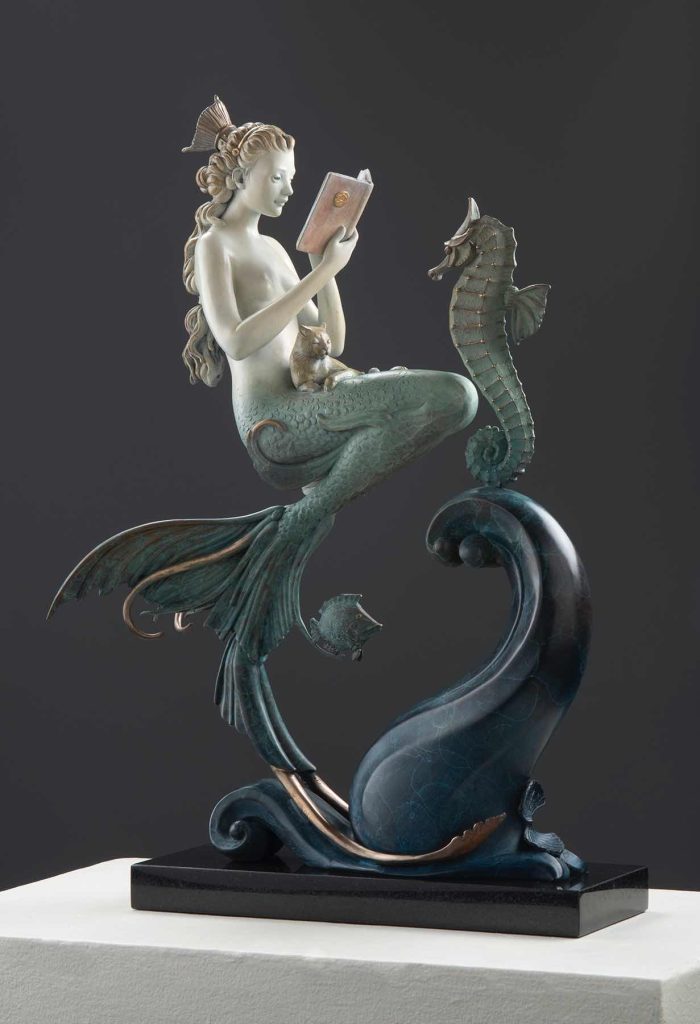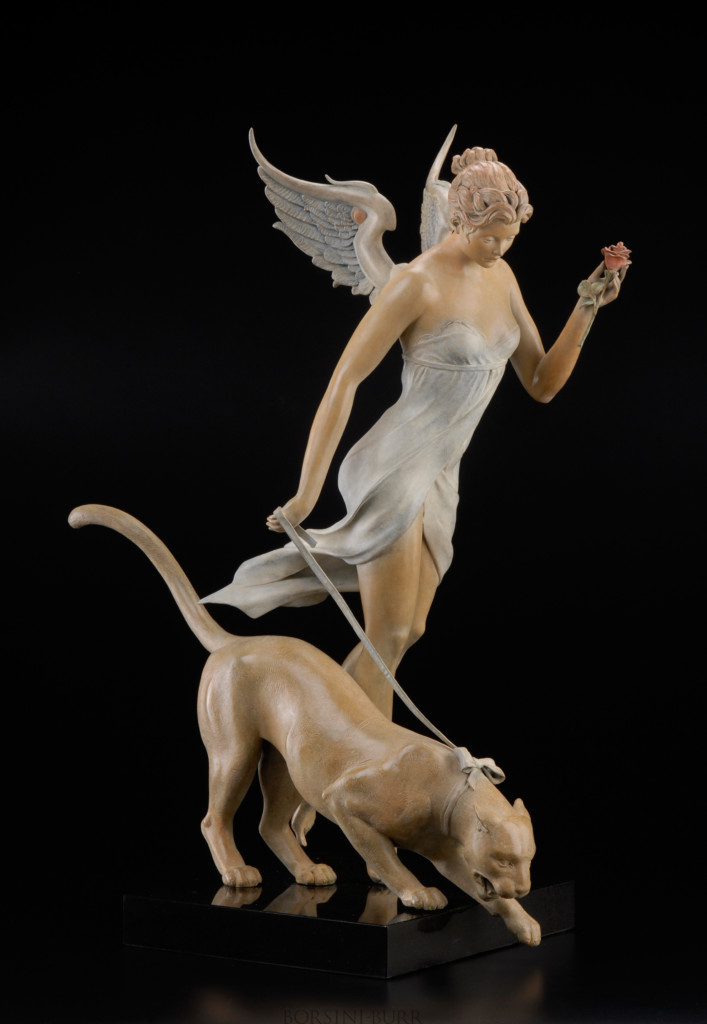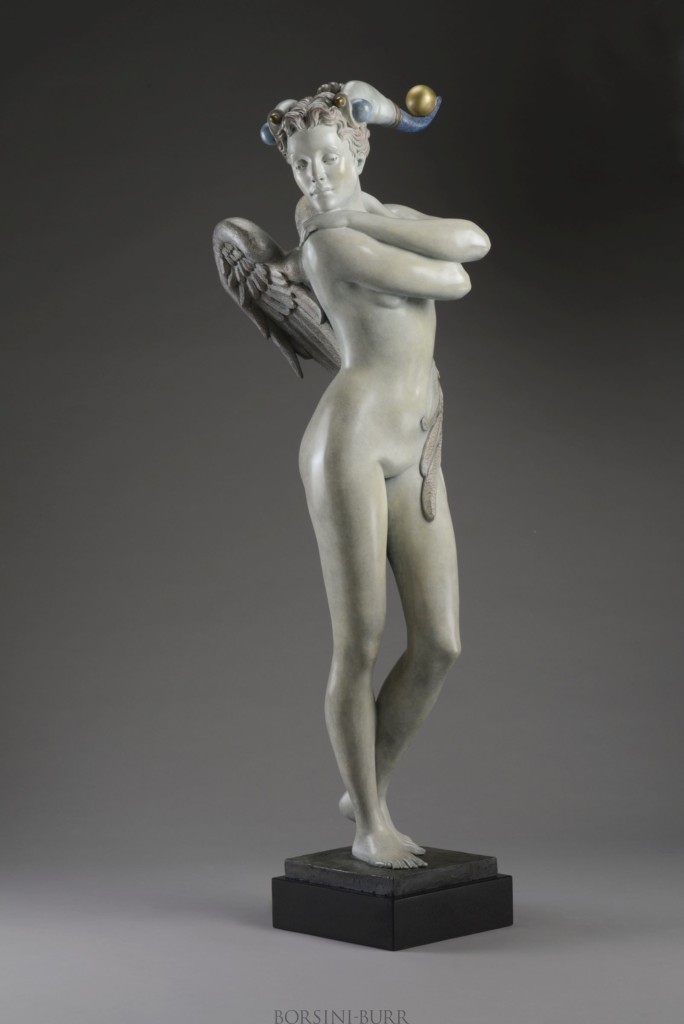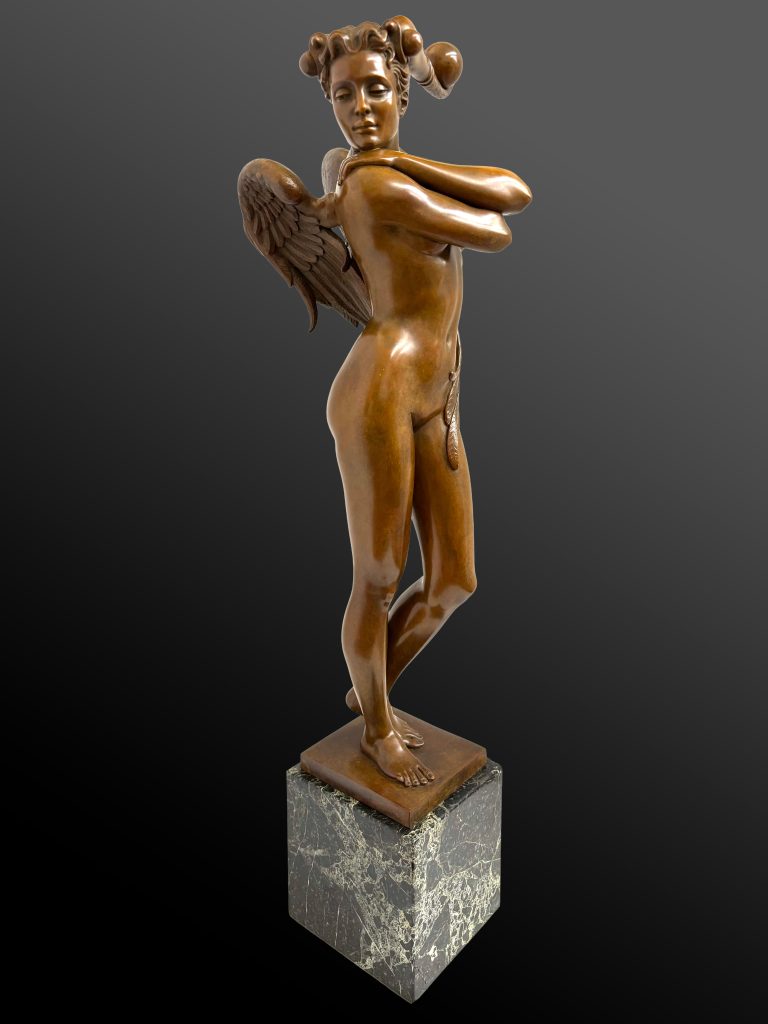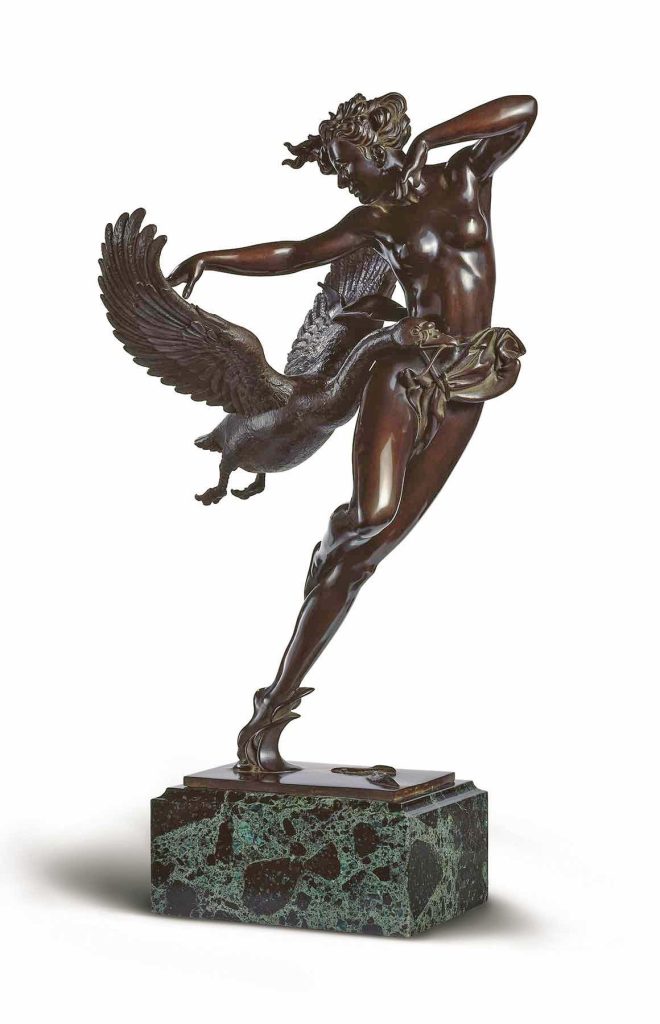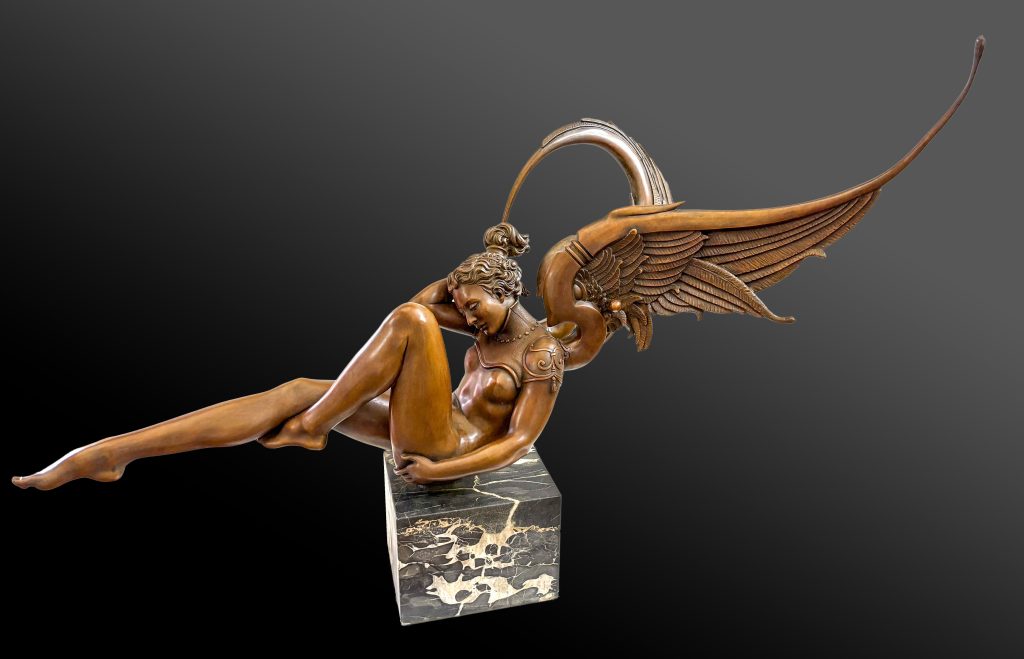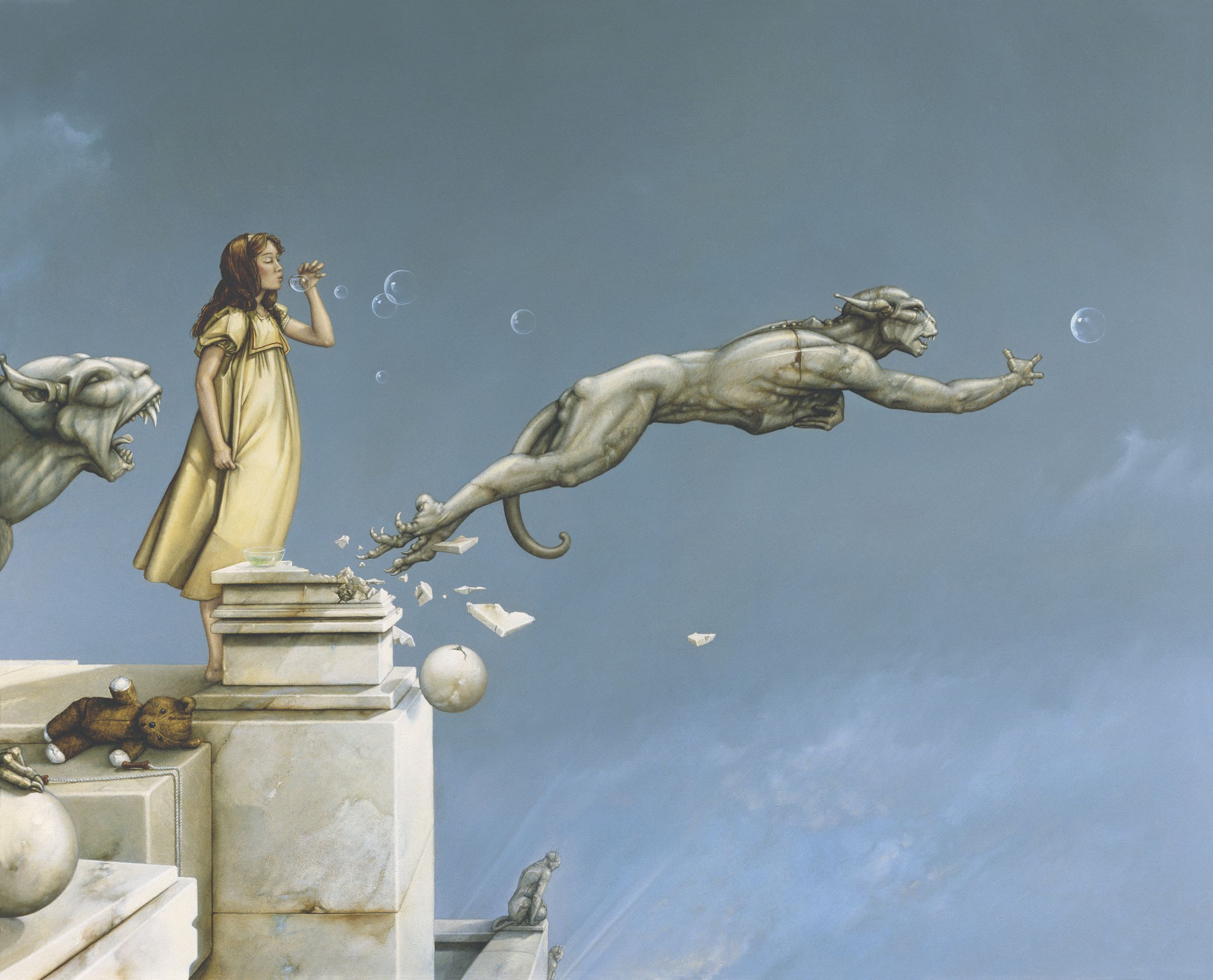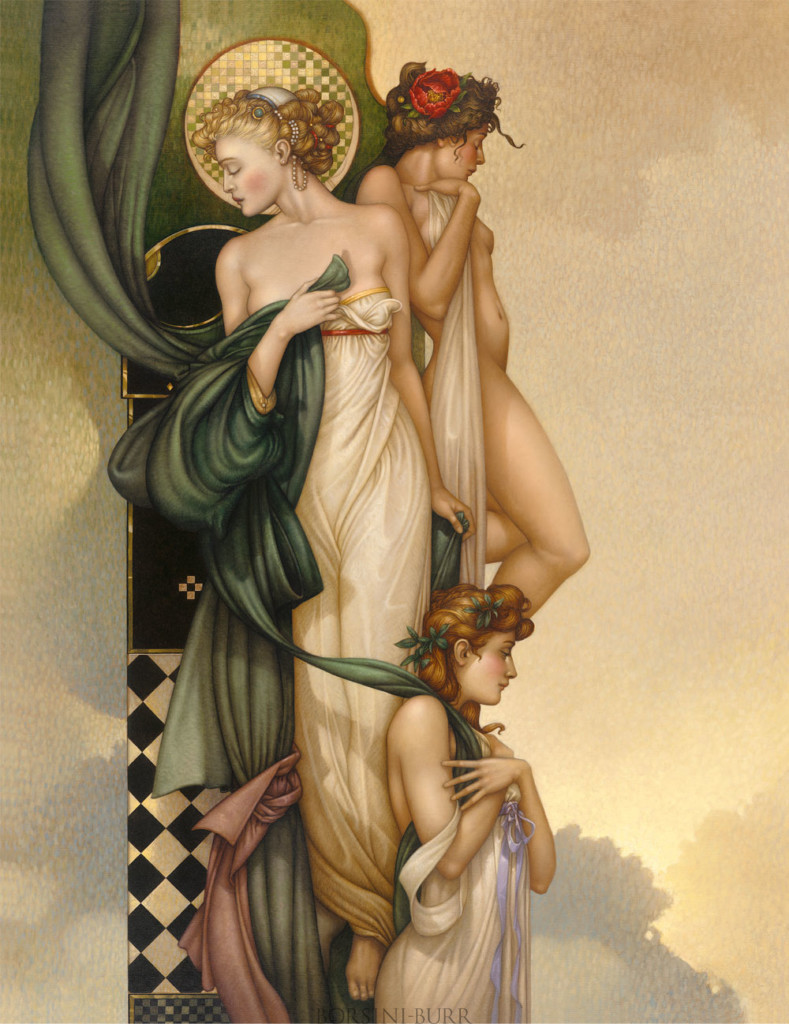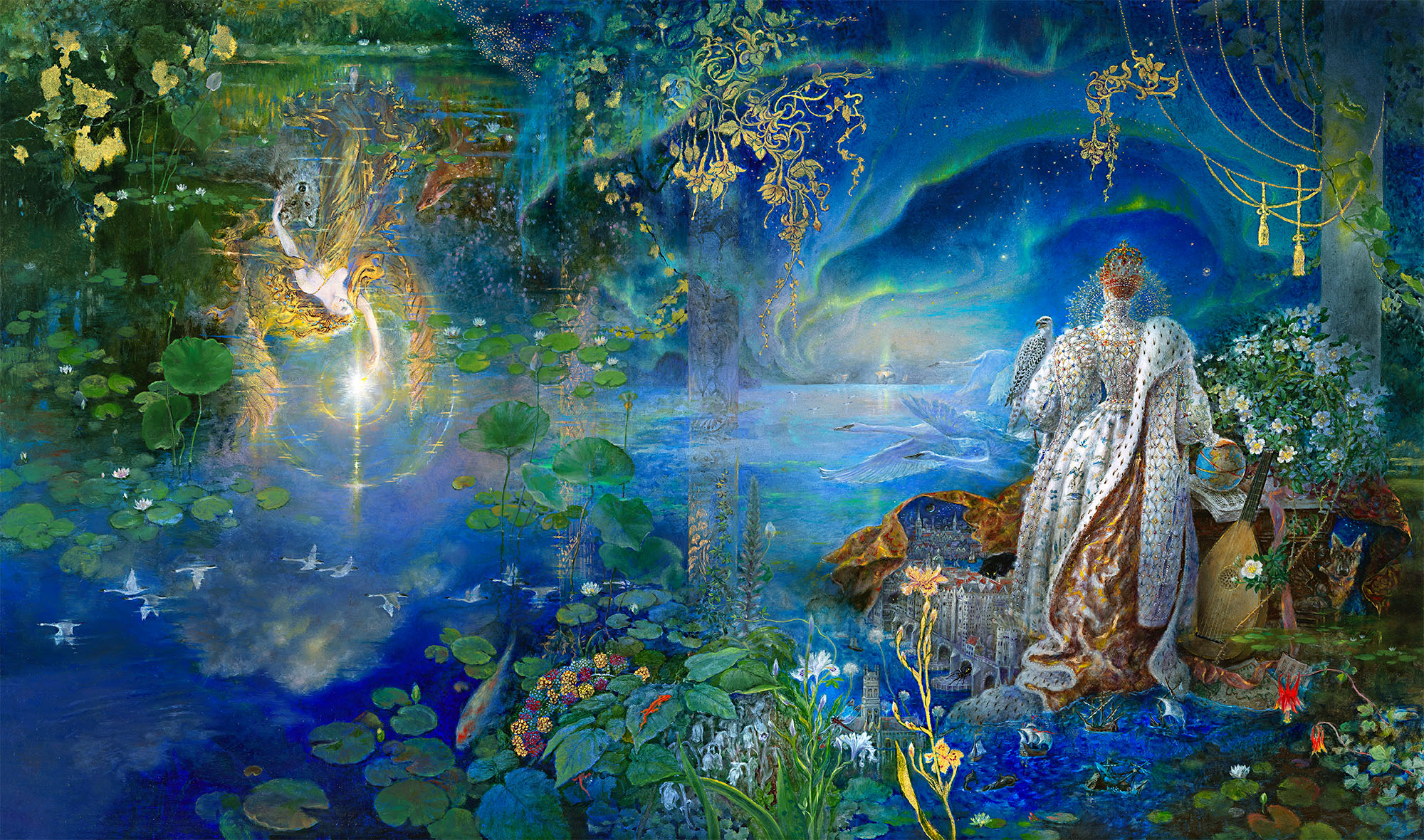Michael Parkes
View Available Sculpture by Michael Parkes.
Michael Parkes is an American artist who resides in Spain and primarily works in the realm of Magical Realism. He has produced a large body of work over his 50 year career, including painting, drawing, sculpture, stone lithography, and limited edition giclee prints. His artworks are found in the collections of celebrities, discerning private patrons, and galleries spanning the globe.
In June of 2024, Michael Parkes announced he would be semi-retiring to spend more time with his loved ones. On August 15th, 2024, the last of the Michael Parkes Fine Art Editions were sold to collectors, ending the supply of new authorized limited editions of his work.
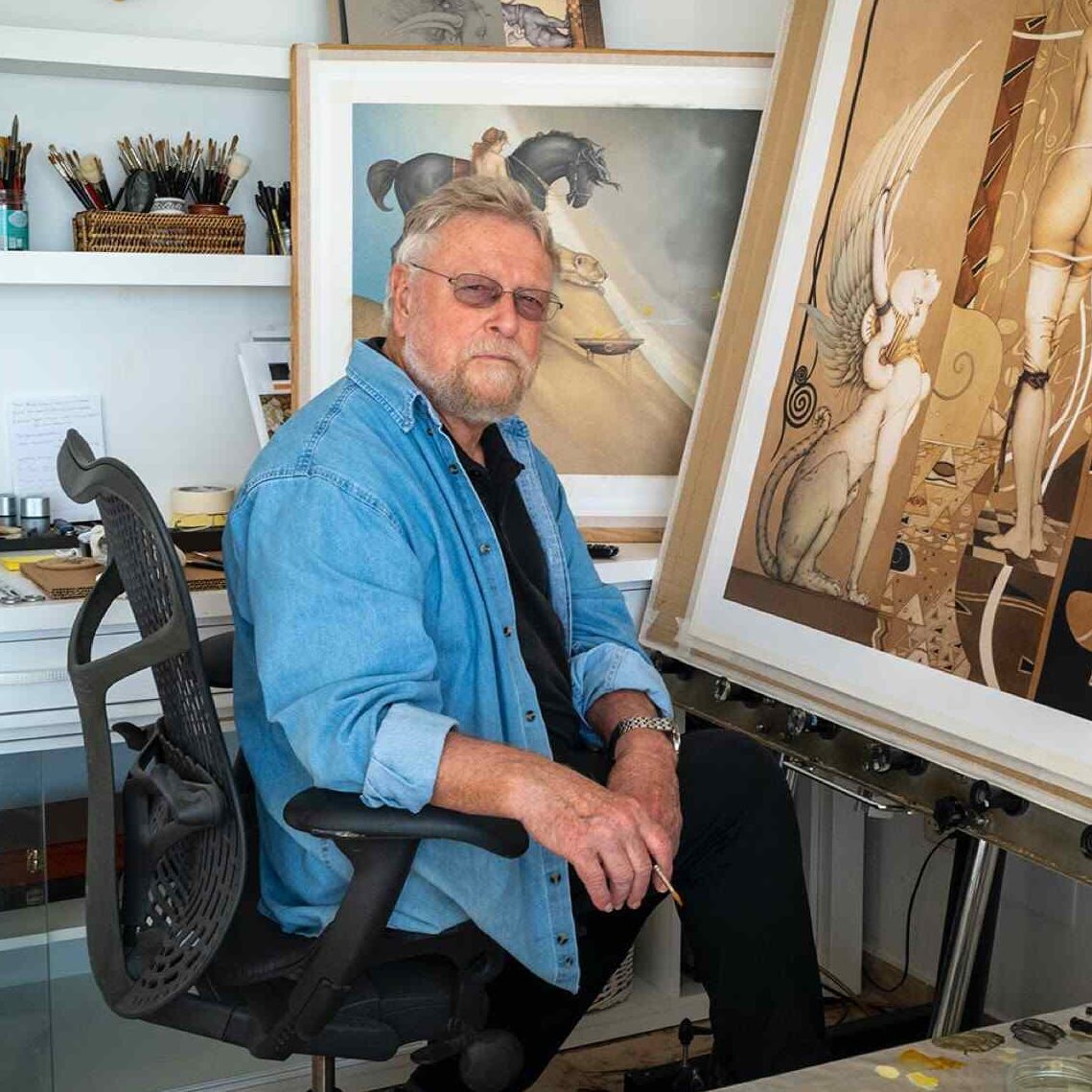
Michael Parkes Sculpture for Sale
About Michael Parkes
Born in 1944 in Sikeston, Missouri, Parkes has described himself as an avid reader from a very young age, and he was especially drawn to books on philosophy and religion. He went on to study painting and graphic arts at the University of Kansas, but like so many of his generation (it was the 1960’s after all), he felt compelled to embark on a spiritual search for deeper meaning. At 24 years old, he and his wife, Maria Sedoff, moved to India with the intention of living there long term. During this time he abandoned painting altogether as he searched for deeper truths and higher meanings.
Years would pass – searching, meditating, learning – before he moved to Spain in 1975 and began to paint again. While he had initially worked in the Abstract Impressionist style typical among his teachers, his return to painting saw him seeking to more faithfully reproduce the fantastic images of his inner world. Striving for more realism in his work, while working with subject matter that was undeniably magical, his work came to embody the spirit of Magical Realism. The term was not new, coined by German art critic Franz Roh in 1925, but it wasn’t until Parkes’ work in the latter half of the 1970’s that the world saw the modern definition of Magical Realism brought to life on canvas.
It was in 1977, in Amsterdam, that the art world was introduced to Michael Parkes through his first one man show, followed by additional solo exhibitions at Basel Art in Switzerland, Art Chicago, Art Fair NY, Frankfurt Bookfair, Amsterdam Art Fair, Tefaf Art and Antiques Fair Maastrich, along with many exhibitions in their galleries in Amsterdam and New York.
The art world may have been intrigued by Parkes’ early work, but it was Gargoyles, painted in 1985, that thrust him into the mainstream consciousness. First seen at the Basel Art Fair, it went largely unappreciated in its first public showing, but after being reproduced as a poster for the North American market, it exploded onto walls everywhere – dorm rooms, offices, living rooms. If you were alive in the late 1980’s, you surely encountered a print of Gargoyles at some point, even if you didn’t know the artist. A young girl on the cusp of womanhood, testing some mystical powers still not understood, bringing her stone guardian to life to engage in a last bit of childhood play. It’s a visual that asks more questions than it answers, and that might be part of the magic behind the art of Michael Parkes.
Not content to simply master the art of painting, Parkes next devoted himself to the practice of Stone Lithography, and continued working in the medium until he was considered one of the few living masters of the craft. He then turned his eye to sculpture, working in Italy to bring his magic to life in bronze. And finally, as the 20th century drew to a close, he produced his first fine art limited edition, The Last Lion, making his work accessible to an even wider audience of collectors. That first fine art edition sold out almost immediately and is still highly sought after by collectors.
It was also around the turn of the century that Michael Parkes came to know Dianne Borsini-Burr – first as a collector, then as a gallerist, and finally, in 2008, as the exclusive representative for his original artwork. Dianne worked tirelessly to bring Parkes’ unique vision to art lovers worldwide, and that audience was about to grow even larger thanks to a best-selling author.
Dan Brown, writer of The DaVinci Code and other acclaimed novels, saw The Three Graces and fell in love with it. He sought out the original oil on canvas and acquired it for his personal collection. It then found its way into Brown’s own work – the painting is referenced repeatedly in his 2009 novel The Lost Symbol. Brown is far from the only luminary with artwork from Michael Parkes in his collection – something about Parkes’ work has an irresistible appeal.
Parkes is a serious student of the most esoteric teachings of Eastern and Western knowledge, and that deep study is evident in his artwork. His imagery draws from many ancient traditions – Cabalistic, Tantric, Vedic, Buddhist, Egyptian, Greek – incorporating archetypes that everyone can connect with, filtered through his own imagination in an effort to reveal to us a deeper truth. Angels dance with mortals, strange beasts are tamed or unleashed, arcane symbols dance in the margins – this is the art of Michael Parkes, hinting at unseen mysteries and untapped knowledge.
Over the five decades of work, Parkes has continued to perfect his art, and his career as a contemporary fine artist is noteworthy in that he has been able to achieve success in the primary and secondary art markets, with new original work selling almost immediately, limited editions in high demand, and a vibrant aftermarket for his artwork. The only limit on how fast Michael Parkes paintings can sell would seem to be how quickly he can paint them! Parkes continues to paint today from his home on the coast of Spain.
If you’d like to be notified about opportunities to acquire one of his original paintings, contact Dianne Borsini-Burr.
Michael Parkes on Dianne Borsini-Burr
In this video, acclaimed artist Michael Parkes shares insights into his 23-year collaboration with Dianne Borsini-Burr, owner of Borsini-Burr galleries and his exclusive representative. This behind-the-scenes look into his creative process and partnership with Dianne Borsini-Burr is a must-watch. Tune in now to discover the secrets behind one of the most successful artist-representative relationships in the art world.
Dianne has such energy, such enthusiasm… if you are an artist, and you have that kind of support mechanism behind you, why would you go anywhere else?
— Michael Parkes
Words from Michael Parkes on Magic and the Muse
Creativity, Intuition, and Inspiration
There are a lot of negative things to be said about getting old, but as I reach 75, there are also some good things. There has been plenty of time to ask questions and possibly find some answers. There has been time to make a lot of mistakes and possibly learn from them, and also, time to find magic in the most unexpected places.
Having a sense of humor and being married to someone you love for 50 years helps a lot when things aren’t so good.
But for all of that time of searching, studying and trying to ask the big questions, there is one mystery I have never solved. It is the mystery that is close to me and I embrace it everyday of my life. What is the act of Creation? How does it work? Is Inspiration something that comes from within, or is it a gift that comes from an outside source?
Creativity is not exclusive to the Arts. That creative zone can be found in business, science, mathematics and even sports. In fact everyone has had some experience of this. The only reason we talk about creativity more in the arts is because the concept is cultivated and used daily to create something to show to an audience. Einstein’s creative genius can be understood by few, but Rembrandt and Bach wanted to communicate their ideas with the public and therefore they were able to reach a much larger audience.
The Mystery of Things
I stand in front of a painting I have been working on for over two weeks. I can see no solution. The composition is boring, the symbols that are supposed to tell a story don’t, and I have had enough. It’s time to cut my losses and destroy the painting. But first I go downstairs to make a coffee and muster the strength to erase two weeks of work. While the coffee is getting ready, it suddenly happens…I see a vision of the finished painting in every detail. It is exactly what I had hoped. I grab a paper towel and pencil to sketch the changes that I have seen because the image is already fading. It is as though my normal brain cannot sustain this thought for very long. There is no rush upstairs to the studio because I know the changes will work. I have just had one of “those moments”.
The logical people among us will suggest that what happened was an extension of normal, linear thought clicking the final pieces into place. I had been pondering different solutions to this painting for two weeks. My mind finally put those pieces in the proper order. Suddenly the solution is unveiled…there is no magic involved!
But those who have had this type of experience of grabbing a napkin, a scrap of paper, or even toilet paper to capture a moment of inspiration that is fading before their eyes will disagree. If this kind of unique thought were just the completion of a linear process, would it come in a flash, complete in every detail and then instantly start to disappear like a dream one has upon awakening? I know my mind and ego well enough, that if that idea belonged to my brain I would be celebrating its achievement and waving a banner for everyone to see…instead of watching the idea quietly disappear into the background.
So it seems that there is a process outside our normal logic that is helping the creative process. Most often, these moments of inspiration produce a solution that is far superior to any I would normally conceive.
Storyteller
More than anything else, I am a storyteller and that is usually where a painting starts…with a story. I make many thumbnail sketches of an idea to see if it can transform into a visual image. If I have nothing after 10 or 20 sketches, I feel this story is not going to be a painting.
But sometimes an amazing thing happens. When I am doing something disconnected from painting, like walking my dogs, I suddenly can see the completed painting in my mind. However, it is not the continuum of the sketches I have been working on, but a completely different idea. It is a unique image and better than anything that I could have created out of the sketches.
Here is where I begin to understand that it was not my ordinary mind that gave me this image. When I make a rapid sketch to remember the image, I know that the battle has just begun. Upon returning to my studio it will take three weeks or a month to make the finished painting following the sketch. This is when my normal mind starts to take interest and interact with the idea. As I start to block in the painting using my sketch, my brain starts making suggestions: Should the sky be that color? Shouldn’t the horizon be lower with more clouds? Do you really need the cat? Sometimes I almost give up as the original image that came to me in a flash begins to fade. This is where that original sketch remains my lifeline to save the painting as originally conceived. Because many people have asked me about these sketches, I have included a section called, “ The Sketch Book ” in this book.
The Muse
Traditionally, the artist is seen isolated in a studio, alone, tormented and the act of creation is completely a personal struggle. But often painters will explain that there is somehow a dialogue between the artist and his canvas. A writer says the subjects of his creation tell him how they need to resolve his story. There is an interaction between the creator and the created.
Other times I have heard artists try to explain the feeling that there is something else in the room that is gently guiding the work in the right direction. So let us assume for a moment that one is not alone in the creative process. You have an idea and you put in the hard work to make the image. At this point the work is technically good and even the story line is interesting, but it has no magic.
This is when you want to call on something or someone who can help you sprinkle the magic dust on your hard work. But this is not how it works, because if you could call on demand this help, every painting would be magical and every painter would be a genius.
When and how a muse arrives is the great mystery.
The River
One of the ways my muse arrives is very sneaky indeed.
I am working on a painting that just is not getting any better and I have been painting backwards for several days. Then something happens! I call it ‘Stepping in the River’ because one is suddenly moving with a kind of current. Time seems suspended and you start painting like you have never painted before. Every brush stroke is the ‘right’ brush stroke; every color is in just the right place. Interestingly, I watch my hand mixing colors that are not in my normal pallet and everything is working. I learned very early not to stop when the river is flowing…not eat, not take a short break and never a siesta. Any of these actions sever the connection.
To explain how this experience is not just my having a ‘good painting day’, I want to recall one of my worst, best painting days ever!
I had a horrible flu and trying to feel a bit better, and feeling sorry for myself, I drank too much wine. The next morning with a flu hangover, I knew there was no way I was going to work. But I did want to see what I had done for the several days before. So I went to my studio for just a moment. There was a small correction I wanted to make, so I sat down a moment in my chair before I went back to bed.
Seven hours later, I had had the painting day of my life. Everything I touched was beautiful, much more than I am capable of. If I wanted to paint an angel with a green face, she would the best green angel ever painted.
So, on top of everything else, my muse has a wicked sense of humor!
Painting the Goddess
So by now you must be thinking, do I really believe in this muse creature? Well, I can go this far: there is an energy that is not mine. It is feminine in feel and texture and it interacts with me on a regular basis.
Here are some things I do know: When I decided to start painting again after an almost 10 year break, I wanted to paint that Feminine energy. I had traveled and studied philosophy and metaphysics in India and other places and I was now ready to try and tell the stories I wanted to tell. There had to be a new visual language and direction that would eventually be called, ‘Magic Realism’, but in the beginning it was just a vague direction.
These stories needed characters to populate this new world. From the beginning I wanted to take an abstract philosophical discussion and make it pictorial.
I think of humanity as isolated and existing between two gaps: One separating us from the animal kingdom and the other from the so-called gods, angels and divine beings. In the early paintings, I wanted to try to fill in creatures between the animal world, the humans and the world of angels and other deities.
From the many ancient traditions, I looked for the common source from which all religions arose, the source of the Sacred River. From there I pooled what I thought were the most solid archetypes from each tradition. Working with these archetypes helped me understand that many of the ancient philosophers were correct: There is a mathematical, harmonious beauty and calm that can be obtained by the correct balance of colors and symbols that everyone can perceive.
If there were such a thing as a paint color called ‘calm’, that would be the first thing I would apply on the canvas before I started a painting. Regardless of how active the image is, I want a feeling of inherent calm and harmony in the finished result. The other thing that enables the symbols to work is that they transport the viewer to a timeless space so that one is unsure whether one is a hundred years in the future or a thousand years in the past…but it is a place you want to enter and explore. And many times it feels familiar, as if it is part of your distant memory.
Devas
There are beings in the hierarchy of angels with special responsibilities. They are designers. They create the living things of our planet from inert matter. From the smallest flower to the largest most majestic creature, each living thing on this earth has its own Deva. They have created and cared for life on Earth. These creations are nourished and loved by them until they cease to exist. This story connects directly to my belief in the beauty and mystery of our earth and that it must be cared for at all cost.
My painting ‘The Last Lion’, created in 1996, is an example of that concern. A Deva waits with her creation until the very end. It is not just her lion that is being lost, but he represents the extinction of the whole species. The Devas are immortal, so imagine creating this beautiful creature that is bound by time and space and watching it cease to exist. The laws of our world do not allow her to save her creation if it is the condition of our world that is destroying it
The Muses and Devas are a part of my life long work: to paint the Feminine energy that brings beauty, balance and order to our world.
The Cosmic Circus
My earlier paintings were about the circus. I had to find a way to make magic happen in broad daylight, so I created masks, headdresses and costumes that made the viewer realize that they were in no ordinary place. The paintings were to talk about human consciousness using clowns, acrobats and dancers as symbols. I was interested in the idea of the sky or the ledge high up in the sky as the edge of normal human consciousness. If one accepts the idea that the play of that consciousness is like a circus, one can surmise that being high in the sky, on a tightrope or cliff, is the final step before one falls or flies.
The Collectors
The series of these little creatures was made when I was still making stone lithographs. They were really a children’s tale for my daughter. The idea was very simple: The Collectors were small beings that became obsessed with everyday objects they found beautiful. I was hoping that viewers would see the Collectors and their objects in a new and fresh light and find them as miraculous as the Collectors did.
Fairies, Nymphs, Dragons and Mermaids
When I started painting again, I needed to populate my paintings with creatures that could help me tell the stories I wanted to tell…creatures that make one feel like a child again, embraced by wonder and not alone in this vast universe.
Moon birds, baby dragons, talking fish, gargoyles, fairies and nymphs filled the spaces around the animal kingdom so we had a connection we did not have before. Even the giant cats that accompany the Devas were important to keep them grounded in earth’s atmosphere.
As much as I love my dogs, they still do not understand what the moon is, let alone Shakespeare. When they watch me sitting in one place everyday with brushes in my hands and smelly oil paint on the table, they just look bemused. Sometimes the little one sleeps on my lap and the big one on my feet while I work, but if I could just once discuss the idea of the painting with them, it would be magic. They do, however, seem to enjoy music with me, especially Bach and Willie Nelson!
Of all the creatures I have painted, I am especially fond of the mermaids. They are the perfect symbol that bridges our ancient evolutionary past and our relationship to water. I live by the sea and at night I hear the waves. It is no wonder I dream of mermaids.
Dream Time
Speaking of dreams…I am often challenged by people who declare that fantasy and symbols are not a part of their life. They live in the ‘real world’. I then remind them that they spend half of their life in my world. They sleep and they dream. Jung’s study of the Collective Unconsciousness ties all of us together during the dream state with common symbols to help us understand our own dreams. He puts it like this:
‘Without the playing with fantasy no creative work has ever yet come to birth. The debt we owe to the play of imagination is incalculable. ‘ Carl Jung
So like it or not, if you have a response to my world, it is because at some point it overlaps with yours…even if it is at night.
Michael Parkes
Summer, 2019
Andalucía, Spain
There are numerous people who I want to thank who have helped me immeasurably in my life’s work: Maria, my wife who always tells me the truth, Auromira, my daughter who inspires me with her spirit, Dianne Borsini Burr and Mark Eaker, my most amazing agents, Marcel Salome, graphic and book designer extraordinaire, Helmut Fritz and Peter Kunts, the best stone lithographers of the 20th century who enabled me to create my images on stone, and Piero Bertelli and Antonella Bertelli, two extraordinary sculptors who have guided and taught me how to make sculpture. But above all, I want to thank the Muses who continue to watch and guide me to this day.


